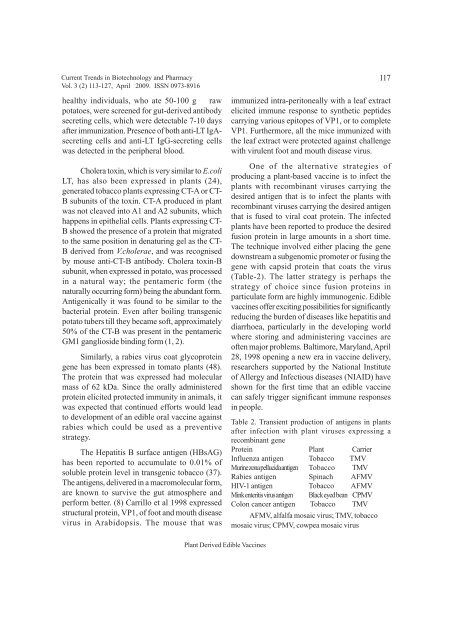April Journal-2009.p65 - Association of Biotechnology and Pharmacy
April Journal-2009.p65 - Association of Biotechnology and Pharmacy
April Journal-2009.p65 - Association of Biotechnology and Pharmacy
Create successful ePaper yourself
Turn your PDF publications into a flip-book with our unique Google optimized e-Paper software.
Current Trends in <strong>Biotechnology</strong> <strong>and</strong> <strong>Pharmacy</strong><br />
Vol. 3 (2) 113-127, <strong>April</strong> 2009. ISSN 0973-8916<br />
healthy individuals, who ate 50-100 g raw<br />
potatoes, were screened for gut-derived antibody<br />
secreting cells, which were detectable 7-10 days<br />
after immunization. Presence <strong>of</strong> both anti-LT IgAsecreting<br />
cells <strong>and</strong> anti-LT IgG-secreting cells<br />
was detected in the peripheral blood.<br />
Cholera toxin, which is very similar to E.coli<br />
LT, has also been expressed in plants (24),<br />
generated tobacco plants expressing CT-A or CT-<br />
B subunits <strong>of</strong> the toxin. CT-A produced in plant<br />
was not cleaved into A1 <strong>and</strong> A2 subunits, which<br />
happens in epithelial cells. Plants expressing CT-<br />
B showed the presence <strong>of</strong> a protein that migrated<br />
to the same position in denaturing gel as the CT-<br />
B derived from V.cholerae, <strong>and</strong> was recognised<br />
by mouse anti-CT-B antibody. Cholera toxin-B<br />
subunit, when expressed in potato, was processed<br />
in a natural way; the pentameric form (the<br />
naturally occurring form) being the abundant form.<br />
Antigenically it was found to be similar to the<br />
bacterial protein. Even after boiling transgenic<br />
potato tubers till they became s<strong>of</strong>t, approximately<br />
50% <strong>of</strong> the CT-B was present in the pentameric<br />
GM1 ganglioside binding form (1, 2).<br />
Similarly, a rabies virus coat glycoprotein<br />
gene has been expressed in tomato plants (48).<br />
The protein that was expressed had molecular<br />
mass <strong>of</strong> 62 kDa. Since the orally administered<br />
protein elicited protected immunity in animals, it<br />
was expected that continued efforts would lead<br />
to development <strong>of</strong> an edible oral vaccine against<br />
rabies which could be used as a preventive<br />
strategy.<br />
The Hepatitis B surface antigen (HBsAG)<br />
has been reported to accumulate to 0.01% <strong>of</strong><br />
soluble protein level in transgenic tobacco (37).<br />
The antigens, delivered in a macromolecular form,<br />
are known to survive the gut atmosphere <strong>and</strong><br />
perform better. (8) Carrillo et al 1998 expressed<br />
structural protein, VP1, <strong>of</strong> foot <strong>and</strong> mouth disease<br />
virus in Arabidopsis. The mouse that was<br />
117<br />
immunized intra-peritoneally with a leaf extract<br />
elicited immune response to synthetic peptides<br />
carrying various epitopes <strong>of</strong> VP1, or to complete<br />
VP1. Furthermore, all the mice immunized with<br />
the leaf extract were protected against challenge<br />
with virulent foot <strong>and</strong> mouth disease virus.<br />
One <strong>of</strong> the alternative strategies <strong>of</strong><br />
producing a plant-based vaccine is to infect the<br />
plants with recombinant viruses carrying the<br />
desired antigen that is to infect the plants with<br />
recombinant viruses carrying the desired antigen<br />
that is fused to viral coat protein. The infected<br />
plants have been reported to produce the desired<br />
fusion protein in large amounts in a short time.<br />
The technique involved either placing the gene<br />
downstream a subgenomic promoter or fusing the<br />
gene with capsid protein that coats the virus<br />
(Table-2). The latter strategy is perhaps the<br />
strategy <strong>of</strong> choice since fusion proteins in<br />
particulate form are highly immunogenic. Edible<br />
vaccines <strong>of</strong>fer exciting possibilities for significantly<br />
reducing the burden <strong>of</strong> diseases like hepatitis <strong>and</strong><br />
diarrhoea, particularly in the developing world<br />
where storing <strong>and</strong> administering vaccines are<br />
<strong>of</strong>ten major problems. Baltimore, Maryl<strong>and</strong>, <strong>April</strong><br />
28, 1998 opening a new era in vaccine delivery,<br />
researchers supported by the National Institute<br />
<strong>of</strong> Allergy <strong>and</strong> Infectious diseases (NIAID) have<br />
shown for the first time that an edible vaccine<br />
can safely trigger significant immune responses<br />
in people.<br />
Table 2. Transient production <strong>of</strong> antigens in plants<br />
after infection with plant viruses expressing a<br />
recombinant gene<br />
Protein Plant Carrier<br />
Influenza antigen Tobacco TMV<br />
Murine zona pellucida antigen Tobacco TMV<br />
Rabies antigen Spinach AFMV<br />
HIV-1 antigen Tobacco AFMV<br />
Mink enteritis virus antigen Black eyed bean CPMV<br />
Colon cancer antigen Tobacco TMV<br />
AFMV, alfalfa mosaic virus; TMV, tobacco<br />
mosaic virus; CPMV, cowpea mosaic virus<br />
Plant Derived Edible Vaccines













